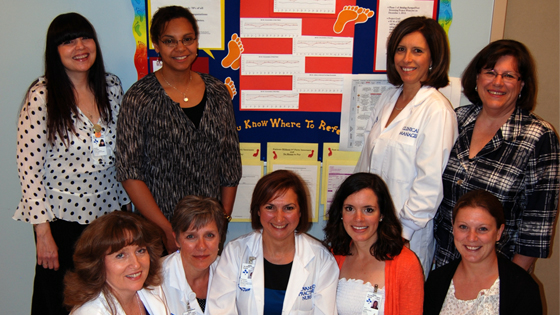
Members of the Foustanellas Endocrine and Diabetes Centre team use a storyboard (in the background) to track improvements to their foot-ulcer screening plan.
Foot ulcers are a common, often-preventable complication of diabetes. Recent reports indicated Eastern Ontario has a disproportionately high incidence of lower-extremity amputation and hospital admissions for infected foot ulcers as well as low foot-screening rates. In response, The Ottawa Hospital made improvements to diabetes foot-ulcer prevention.
The Foustanellas Endocrine and Diabetes Centre at the Riverside Campus designed a foot-ulcer risk-assessment tool and process that helped staff immensely and changed the culture of practice. By tracking the implementation process, the number and accuracy of foot assessments and the proportion of patients diagnosed as higher risk for foot ulcers, staff are working together as they ensure targets are met and their patients receive the best possible care.
“This was not a simple fix,” said Brigitte Skinner, quality improvement coordinator. A multidisciplinary working group was established to help everyone understand the situation at the start and the factors that affected patient care. Improvements were tested and constantly adjusted. A storyboard tracked weekly progress for all staff to see.
“We standardized the process and ensured that a foot-ulcer risk assessment was always completed,” said Dr. Janine Malcolm. “We provided self-management education to all of our patients diagnosed as higher risk.”
Now, more than 90 percent of newly referred patients receive a standardized, five-item foot exam and risk assessment, compared with 20 percent before. “This is an amazing improvement,” reported RN Sharon Brez.
Clinical Manager Sheryl Izzi added that patients are better informed about their risk factors, referrals are made for modifiable risk, charts are flagged for follow-up and high-risk patients are receiving the foot-care education they need.
These improvements show that even in busy, complex environments, practices can be standardized and change can be sustained to provide high-quality, safe patient care.

Support patient care and research at
The Ottawa Hospital


 To reset, hold the Ctrl key, then press 0.
To reset, hold the Ctrl key, then press 0.